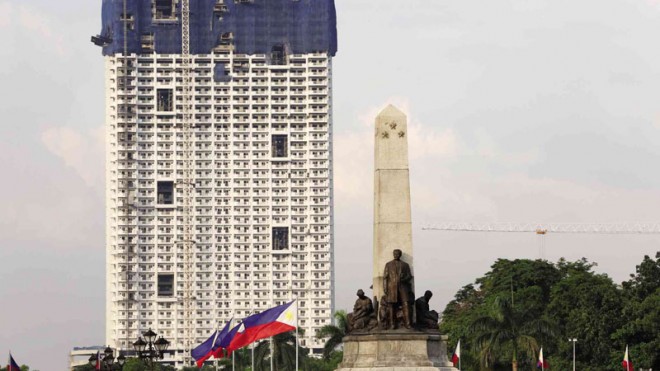Torre de Manila developer: Photobombing not against the law

Towering over Rizal Monument at Luneta Park, the controversial Torre de Manila, described by opponents as an eyesore around the skyline of a heritage site, is almost complete in this June 2015 photo. MARIANNE BERMUDEZ/PHILIPPINE DAILY INQUIRER
The photobombing issue against the P2.7-billion Torre de Manila condominium cannot be the basis of a case because even if some sectors consider the building “annoying” or “offending to the senses,” there is no legal basis to use aesthetics as reason to stop the construction of the 49-story structure.
In a 34-page position paper, DMCI Project Developers Inc. told the high court there was no law prohibiting and penalizing the obstruction of the background, backdrop or view of the Rizal Monument in Luneta Park, Manila.
“Torre de Manila is a legitimate residential condominium project that was demonized in the media as a ‘photobomber’ that would mar the view of the Rizal Monument. However, the concept of photobombing in relation to national monuments and shrines is not in the law,” DMCI told the high court.
“Buildings and high rises, including those around public monuments, are inevitable in metropolitan areas because of the increase in population and the lack of available land space,” DMCI added.
It pointed out that petitioner Knights of Rizal (KofR) could not rely on the zoning ordinance which limited the maximum gross-floor-area-to-area-of-the-plot ration to 4 because it had been suspended by the executive branch.
Article continues after this advertisementDMCI added that it was able to secure a formal exemption from the floor area restriction under the zoning ordinance which was subsequently approved by the City Council of Manila. It said that aside from the city council, there were also stamps of approval from the Manila City Planning and Development Office as well as the Manila Zoning Board and Adjustments and Appeals.
Article continues after this advertisement“In short, the construction of Torre de Manila bears the stamp of approval of various offices in the City of Manila performing different and independent functions … the official acts of which enjoy the presumption of regularity which petitioners bare and unsubstantiated allegations of irregularities cannot overturn,” DMCI said.
It also said that Torre de Manila could not alter or affect the integrity of the area since it is 870 meters away from the Rizal Monument and around 30 meters away from the outermost edge of Luneta Park.
The developer noted that several prominent Filipinos, such as National Artist for Literature F. Sionil Jose, urban planner architect Felino Palafox Jr. and the Philippine Chamber of Real Estate and Builders’ Associations Inc., have independently issued opinions and statements defending Torre de Manila from bashing in the media.
It also warned that a ruling against the construction of Torre de Manila would create a dangerous precedent and result in “economic havoc.”
In particular, DMCI cited the runabout at Bantayog ni Bonifacio in Caloocan City where an SM supermarket and other buildings stood; Bonifacio Monument on J.P. Rizal Street in Makati City where several high-rise condominiums and commercial buildings had been built, and other monuments such as Edsa Shrine in Ortigas Center; Liwasang Bonifacio in Ermita, Manila; Ninoy Aquino Monument in Makati City, Rizal Monument in Zamboanga City, statue of Arsenio Lacson in Manila and monument of Gen. Pio del Pilar in Makati City.
“A ruling directing the demolition of Torre de Manila will have the practical effect of evicting thousands of residents of high-rise condominiums, knocking down malls and public markets, and tearing down banks, hospitals and other industries crucial to business and the national economy,” it explained.
As of May 31, DMCI said it had spent P1.28 billion for the construction of the building and would lose about P4.27 billion in capital investments and unrealized profits should the court order it to be demolished.
“Petitioner seeks to enjoin the construction and development of Torre de Manila and to demolish it to secure for the general public the continued enjoyment of the Rizal Monument and its surroundings, free of the supposed obstructions of tall buildings such as Torre de Manila. This constitutes public purpose within the contemplation of eminent domain,” DMCI said.
Assuming that the government’s act of authorizing the construction of Torre de Manila was void, DMCI said the doctrine of “operative fact” should be applied since it relied in good faith on the permits and licenses issued for the project.
Under the doctrine, a judicial declaration of invalidity may not necessarily obliterate all the effects and consequences of a void act prior to such declaration.
“This is not only the most feasible and realistic resolution, but is one that dispenses fairness and justice to DMCI-PDI and all persons that will be affected by an adverse ruling from this Honorable Court,” it said.